Nature as Artist – Chinese Picture Stones
PRIMITIVE - Friday, September 05, 2014 |
|
washing machine |
By Misaki Imagawa
I recall days in my childhood when the whole family would stop and listen to unusual sounds coming from inside the house. It wasn’t that the house was haunted. It simply made unusual sounds. My mother was the best noise detective of us all; she would be still, listen, put her ear to the walls and doors, and wait. One time she tracked a noise down to the washing machine, which instead of rumbling as it should, was clanking and clanging like a stone was being hurled around inside – which it was.
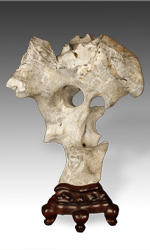 |
|
At that time, my pockets were always filled with rocks and pebbles. I picked them up everywhere: in the woods, on the lake shore, at school, in the city, at parks and at zoos. Flat, smooth stones were my favorite, but I didn’t discriminate. I collected jagged stones, chipped stones, dark and light stones, opaque stones, stones with unusual patterns and stones you would find anywhere. What can I say? I liked stones. I used to hold them and imagine who else in history had touched what I was touching now. For me, stones were a portal to the past. They opened up a world of imagination.
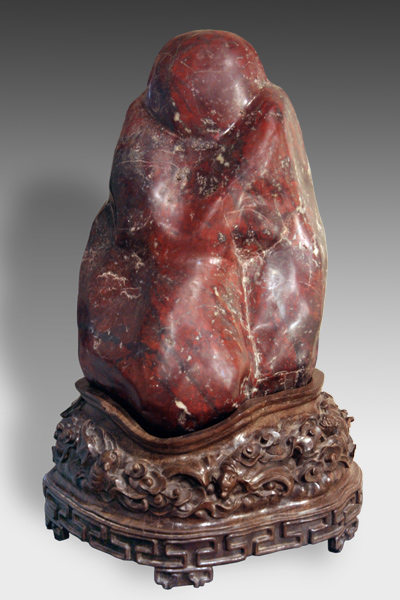 |
|
Though my fascination with rocks annoyed my mother at times – particularly when the washing machine was in jeopardy – there was little she could say because my godfather was a stone sculptor. “Maybe I take after him,” I told her with wide, innocent eyes, but secretly I knew I preferred to simply admire the rocks rather than sculpt them. It wasn’t until later that I learned there was a long tradition of stone contemplation and appreciation in the Far East for particular stones or rocks called Gongshi, which are shaped in highly unusual ways by nature’s hand. For centuries, Gongshi were collected and admired throughout China as objects of reflection and contemplation. In fact, they became so revered they were even given as tribute objects to foreign dignitaries and powerful individuals by the Imperial Court. In the West they are better known as “Scholar’s Rocks” or “Spirit Stones” depending on whether they are abstract or representational.
Many scholars contemplated Gongshi before creating poetry, calligraphy, and paintings. Individual stones were the focus of meditation and a source of inspiration. One look at these remarkable stones can explain how this came to be – Gongshi seem to take on a different shape or form depending on the angle, the lighting or even your mood. Consciousness has even been attributed to some stones. It is no wonder that this unique natural art form continues to be treasured within China and elsewhere. While Gongshi have become increasingly popular among collectors through the years; a related form of natural stone art has also gained popularity. These are called Picture Stones, and in their own way they are as unique and compelling as Gongshi.
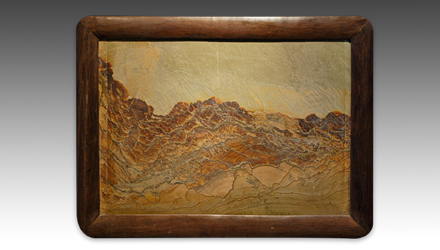 |
Picture stones are cut flat stones depicting exactly what their name suggests – a picture of some sort. Outdoor scenes, images of clouds, forests, mountains and moonlit nights are usually evoked, but people can also make appearances within these stones. When I first saw a Picture Stone I was certain it was a landscape oil painting. The image evoked was that distinct. I say ‘evoked’ because what one person sees in a Picture Stone may be vastly different from what another person sees. Like Gongshi, Picture Stones are purely natural works of art. They are evocative by nature and can be composed of rich colors and textures or simpler, even monochromatic color ways. Yet, the most distinguishing feature of Picture Stones, at least for me, is how they blend eastern and western concepts of art.
In China, Picture Stones are usually incorporated into furniture or framed in other distinct ways. It is not unusual to see them as table or desk tops, featured elements in vertical screens, or mounted in sometimes elaborate wooden bases for appreciation as tabletop objects. However, it is unusual to frame a Picture Stone like a painting – as a singular work of art to be hanged on the wall. This type of treatment is a western idea applied to an art form traditionally appreciated in the east and displayed differently. Yet, this makes perfect sense. Some Picture Stones are as engaging, intricate and compelling as any oil painting you might find in a museum, except the signature shows the piece is by nature itself. Framing one and hanging it on a wall can make it an arresting object demanding to be examined and evaluated as a true work of art.
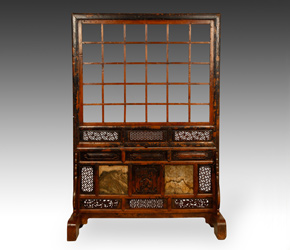 |
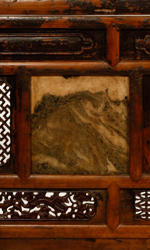 |
In PRIMITIVE’s substantial collection of Gongshi and natural stone art there is a wonderful group of Picture Stones. All the pieces appear to have been cut from one very large block of stone because they have the same color way, or “flavor,” if you will; yet each piece presents a very different image. While one may look like the rolling violent waves of a storm at sea, another looks like a map of the Mediterranean, while still another looks like mountains in the southwest United States. There is no ‘right’ or correct way to present or display these Picture Stones – it is all about what you see when you look at them.
The collection found at PRIMITIVE has been framed in custom made iron wood frames ranging in size from 28-47 inches in length by 17-24 inches in height. They were framed this way so they could be hung on the wall and appreciated as fine art in the traditional western sense. Yet, the appreciation of these fascinating stones is more reliant on their extraordinary aesthetic value than how they are displayed. Coupled with imagination – or perhaps multiplied by it – they are transformed into intriguing, engaging works of art and beauty. Although one could argue rocks are just rocks; when proper framing along with imagination is applied to Picture Stones, East meets West and the centuries old tradition of appreciating these stones is thoroughly refreshed.
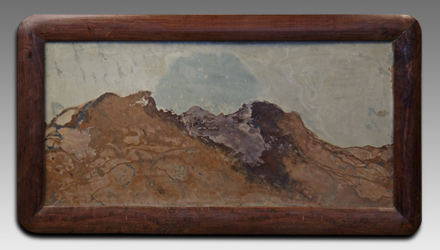
|
|
Download this Article: Nature as Artist.pdf